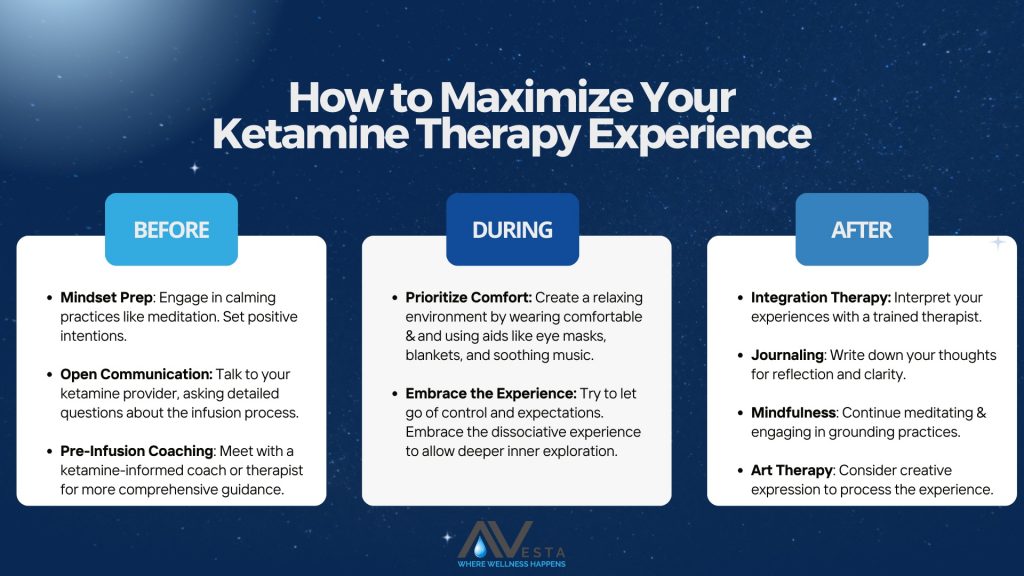In this Post
- Is Ketamine a Psychedelic Drug?
- High Anesthetic Doses vs. Ketamine Therapy
- Psychedelic Ketamine Therapy Experiences
- Comparing Psychedelic Effects: Ketamine Therapy “K-Homes” vs. “K-Holes”
- How Psychedelic Experiences Affect Ketamine Therapy Outcomes?
- Maximizing the Ketamine Therapy Experience
- Post-Treatment Integration
Ketamine is a dissociative drug that can induce feelings of detachment from reality and one’s body. This function makes ketamine a unique treatment for various purposes, like surgical anesthesia, acute pain relief, and chronic pain relief. Ketamine is also powerful for anxiety, bipolar disorder, PTSD, and depression.
For anesthesia, ketamine doses are typically higher and are designed to induce rapid unconsciousness. In contrast, ketamine therapy for mental health starts at much lower mg/kg levels and is designed to improve mood rapidly. Acute pain management ketamine quantities typically fall somewhere in between.
Patients with depression and PTSD generally benefit from low ketamine doses that typically don’t cause hallucinations. However, some people may require larger psychedelic doses to achieve clinically significant outcomes.
Ketamine is a safe option regardless of hallucinations. However, patients considering ketamine therapy should be aware of the psychedelic effects with higher doses to prepare for the experience.
Is Ketamine a Psychedelic Drug?

Ketamine is classified as a dissociative anesthetic, not a psychedelic drug like LSD, DMT, and psilocybin mushrooms. Ketamine can alter perception, consciousness, and mood, like classic psychedelics. But it does so through different mechanisms and with distinct effects.
Ketamine’s primary action is as an NMDA receptor antagonist, which leads to its pain-relieving and out-of-body effects. Classic psychedelics, on the other hand, primarily work by affecting the serotonin system, particularly the 5-HT2A receptor.
Another critical distinction is the duration of the experience. Ketamine experiences usually last only as long as the infusion continues, about 40 minutes. Classic psychedelic experiences can last six to eight hours.
Still, ketamine and classic psychedelics overlap in many interesting ways. Subjectively, both can induce altered states of consciousness and profound personal insights.
High Anesthetic Doses vs. Ketamine Therapy

Ketamine’s dissociative effects vary significantly depending on the dosage. High anesthetic doses used for surgical procedures shut down the brain’s sensory processing and lead to a loss of consciousness and potential hallucinations. Lower doses used for ketamine therapy improve mood and perception without generally causing significant dissociation or visions.
Anesthetic Ketamine
High anesthetic ketamine doses induce a state of unconsciousness unique from typical sleep or general anesthesia. It disrupts the brain’s standard sensory processing by blocking NMDA receptors and disrupting glutamate signaling.
Glutamate, often called the brain’s ‘on’ signal, is a neurotransmitter involved in cognitive functions, learning, and memory. High ketamine doses weaken the glutamate system, resulting in a loss of consciousness and detaching the mind from sensory inputs. Anesthetic doses also affect the limbic system, altering emotional processing and perception.
Interestingly, parts of the brain remain active under ketamine anesthesia, and some patients report hallucinations as they emerge from surgery. These hallucinations can include audiovisual effects, a confusional state, and dissociative feelings of detachment from the body. Dreams and hallucinations usually disappear within a few hours.
Ketamine Therapy
At sub-anesthetic ketamine therapy doses, the compound still acts on NMDA receptors. But to a lesser extent.
Lower doses also affect neurotransmitter systems, like dopamine and serotonin, contributing to antidepressant effects.
The main difference between high anesthetic doses and ketamine therapy doses is that patients often remain conscious and can have a heightened sense of relaxation during therapy. Patients also experience mood and perception changes, typically less intense than in anesthetic doses.
Hallucinations are also much less common during ketamine therapy experiences. However, they can occur if the patient requires larger amounts for clinically significant healing. Importantly, hallucinogenic experiences are just as safe as smaller doses and can be effective for depression, PTSD, and other mood disorders.

Psychedelic Ketamine Therapy Experiences

Ketamine therapy experiences range from euphoric to mind-altering, depending on the dose and patient’s needs. In certain contexts, psychedelic experiences and dissociation are the intended goal.
Psychedelic effects at higher ketamine doses can cause intense visuals and out-of-body experiences. It’s common for patients to feel as though they are watching themselves or their surroundings as if in a movie theater, with the real world slipping away. Many patients feel like their bodies are moving despite laying still.
Common psychedelic ketamine experiences include:
- Visuals of spinning shapes and fractals, whether eyes are open or closed.
- Sensations of floating or the perception that time has ceased to exist.
- Inability to speak or move with precision.
- Confusion and dizziness.
Ketamine’s psychedelic effects can be powerful. In rare cases, some describe the experience as akin to “ego death.” During ego dissolution, the ordinary sense of self or ‘ego’ temporarily disappears. Some people might feel a loss of boundaries between themselves and the external world, leading to a sense of oneness with their surroundings.
Avesta, recognizing the potential of these experiences, refers to them as a “K-home” rather than a “K-hole,” negatively associated with recreational use. “K-holes” are intense dissociated trips that can occur with high doses. “K-homes,” on the other hand, allow patients who feel supported to enter a deeper healing space, finding rapid inner balance post-infusion.
Still, K-home experiences can be uncomfortable. And some patients may choose to reverse course during infusions. Fortunately, patients receiving IV ketamine therapy at Avesta maintain a high level of control over their experience. Those who react poorly or feel anxious about ketamine’s psychedelic effects have options to mitigate discomfort:
- Communication with Clinical Staff: At Avesta’s ketamine infusion clinics, patients can inform the practitioner if they feel uneasy, allowing for real-time dosage adjustments. Avesta’s care team can titrate doses up or down or cease the infusion at any time with rapid results.
- Environmental Adjustments: Sometimes, modifying the environment and the music can help reduce anxiety. At Avesta’s clinics, patients can adjust lighting, play calming music, or ask for calming reassurance from the care team.
- Post-Session Support: After the session, psychological support and counseling can help patients process their experience, especially when encountering challenging moments. Avesta encourages patients to engage in therapy during or close to the infusion schedule.
Comparing Psychedelic Effects: Ketamine Therapy “K-Homes” vs. “K-Holes”

Psychedelic ketamine experiences in monitored clinical environments contrast sharply with non-medical settings. Recreational ketamine use can be scary and extreme, depending on the dosage and the person’s mindset.
Recreational often produce intense visuals characterized by blurriness, abnormal colors, and vivid hallucinations. At high enough doses, people can descend into “K-holes” where they might find themselves in alternative realities, sometimes rooted in memories or entirely fictitious scenarios.
During “K-holes”, users describe transitioning from experiencing slight trippy effects and numbness to entering wildly strange and immersive hallucinations accompanied by the feeling of full-body paralysis.
To onlookers, the person may seem catatonic or unresponsive, but internally, their experience may, in fact, be rich and complex. Dr. David Belin from the University of Cambridge explains that this is due to ketamine’s disruption of the brain’s glutamate system.
Professor David Nutt, a neuropsychopharmacologist, provides further insight. He contrasts ketamine with other sedative anesthetics that induce extreme synchronicity in brain activity. Unlike most anesthetics, ketamine causes fragmented brain activity, leading to a psychedelic state.
Professor Nutt uses an orchestra analogy to explain the process. Nutt explains that while classic psychedelics remove the conductor, letting the orchestra’s sections play their own tunes, ketamine disorganizes the instruments themselves. This can lead to a chaotic and confusing “K-hole” experience, sometimes causing people to revisit previous hallucinations or create entirely new ones.
“K-holes” can be extraordinarily frightening for people. However, ketamine therapy rarely induces intense hallucinations or paralysis. When K-homes occur, Avesta’s trained and caring practitioners support patients and adjust the dose if needed.
How Psychedelic Experiences Affect Ketamine Therapy Outcomes?
Many ketamine therapy patients understandably worry about potential psychedelic effects. However, other patients seek hallucinations because they believe visions can ignite powerful revelations. Both perspectives are valid. But neither is right or wrong.
Ketamine-induced psychedelic experiences are entirely neutral. They are not inherently scary or beneficial. They can be both.
Some experts attribute ketamine’s dissociative effects to its antidepressant powers. This idea stems from ketamine’s unique mode of action and its rapid mood enhancement effects, which are not entirely understood. The theory posits dissociative and psychedelic experiences could break patterns of negative thinking, enabling patients to detach from ingrained harmful beliefs and adopt healthier thought processes.
However, the theory remains entirely speculative, and many practitioners disagree.
Avesta’s clinical care team has witnessed incredible patient breakthroughs, with and without psychedelic effects. Transformations often occur spontaneously 24 – 48 hours post-infusion without the patient’s awareness. That’s why Avesta believes ketamine’s therapeutic impact lies in the compound’s profound cellular impact, far beyond dissociation and hallucinations.
Maximizing the Ketamine Therapy Experience
Patients considering ketamine therapy should mentally and physically prepare for the experience to reduce anxiety about potential psychedelic effects and maximize therapeutic outcomes.

Before Treatment:
- Mindset Preparation: Engaging in calming practices like meditation helps ease anxiety about psychedelic experiences. Setting positive intentions for the session can also establish a mental framework conducive to healing.
- Open Communication: Patients should talk to their ketamine practitioners, asking detailed questions about the infusion process to alleviate concerns.
- Read Patient Testimonials: Seeking patient reviews or testimonials can provide real-world insights into what to expect from ketamine.
- Pre-Infusion Coaching: At Avesta, we recommend patients meet with a trained ketamine-informed coach or therapist for more comprehensive guidance.
During Treatment:
- Prioritize Comfort: Wearing comfortable clothes and utilizing eye masks, blankets, and soothing music creates a relaxing environment and reduces apprehension. At Avesta, we provide eye masks and blankets, but many patients prefer to bring personal items like their favorite pillows and blankets.
- Embracing the Experience: Letting go of control and embracing the dissociative experience can lead to more significant therapeutic outcomes.
Post-Treatment Integration

Engaging in integration therapy post-infusions is also crucial in maximizing the therapeutic potential of ketamine experiences. The process offers a structured way for patients to reflect on and interpret the meaning of their sessions.
Integration involves methods like guided discussions, creative expression, and mindfulness techniques. All methods aim to help patients reconcile ketamine-therapy insights with their everyday lives, facilitating personal growth and psychological healing.
Integration Methods Can Include:
- Integration Therapy: Discussing ketamine experiences with an informed therapist helps patients interpret and understand their meaning.
- Journaling: Writing down thoughts, feelings, and insights post-session helps patients reflect and achieve clarity.
- Mindfulness Practices: Techniques to stay grounded and present, like meditation and yoga, help people integrate ketamine therapy into everyday life.
- Art Therapy: Creative expression techniques provide more tools for people to externalize and process the therapy experience.
The Bottom Line
Ketamine, transcending its traditional role as an anesthetic, is a powerful therapeutic agent for various mental health conditions. Its unique ability to induce dissociative states opens new neural pathways and harnesses the mind’s potential for healing. Ketamine therapy typically doesn’t trigger hallucinations. But psychedelic experiences are safe and can offer transformative benefits.
Avesta has supported over 1,000 patients in its Washington D.C., Maryland, and Virginia ketamine clinics. If you have any questions about ketamine therapy and potential psychedelic side effects, please schedule a free consultation.



